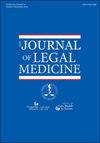Investigating the Relationship Between Opioid Prescription Frequency and Deaths From Illicit Opioids
IF 0.8
4区 医学
Q3 LAW
引用次数: 0
Abstract
Investigating the Relationship Between Opioid Prescription Frequency and Deaths From Illicit Opioids Cara Wyant, OMS-II Taylor Cornwell-Hinrichs, MPH, MLIS, OMS-II Joseph P. Hardy, MD, Associate Dean of Clinical Education Weldon Havins, MD, JD, LLM, MA, Emeritus Professor Touro University Nevada College of Osteopathic Medicine In accordance with the global opioid epidemic, the CDC issued guidelines for practitioners prescribing opioids for chronic pain. In response to these guidelines and to the opioid epidemic itself, Nevada issued restrictive legislation on practitioners prescribing opioids: SB 459, AB 474, and AB 239. To investigate the relationships between opioid legislature and opioidrelated death rates, data was obtained from the Nevada Board of Pharmacy and the Clark and Washoe County medical examiner offices. The data demonstrate that there was a significant decrease in prescriptions following the legislation; however, there was no correlation between the legislation and overall rate of opioid-related deaths because there was a subsequent and dramatic rise in deaths from illicit opioids. This suggests that more patients switched to the use of heroin and/or fentanyl as a result in limiting legal opioid prescribing power. A Spearman correlation was calculated (-0.04) and a two-way analysis of variance (ANOVA) was used to compare the time periods of the legislation implementation and the county. There were no interactions between the two counties and law; so, both counties experienced the same trends following these laws. To compare opioid-related deaths to opioid prescription rate for each time period, a t-test with law as the only factor was conducted with combined data from both counties (SB 459 p1⁄4 0.744; AB 474 p1⁄4 0.640; AB 239 p1⁄4 0.704). No significance was found. The COVID-19 Stay at Home order has statistically increased opioid-related deaths (p1⁄4 0.010), albeit it is unknown if this increase is due to Nevadans selfmedicating in response to work stoppages and financial stress, inability to see a practitioner in person, or restrictions involving addiction clinics during the pandemic. The goal of Nevada’s three opioid prescription bills was to reduce the rate of Nevadans dying from opioid overdoses, yet more Nevadans are dying from opioids now than before the bills passed. We recommend three provisions that will allow providers to confidently prescribe appropriate 2021 American College of Legal Medicine JOURNAL OF LEGAL MEDICINE 2021, VOL. 41, NO. S1, 49–50 https://doi.org/10.1080/01947648.2021.1914493 pain management for their patients without fear of sanction from another licensing board’s misunderstandings, allow providers to humanely manage their patients’ legitimate pain, and limit unintended consequences where patients are forced to seek out illicit opioids to control their pain and inadvertently die in the process. These are our recommendations: (1) Base law requirements on guidelines provided by professional or governmental agencies that are medically oriented, (2) Discipline first with education, then with sanctions, and (3) Enforce requirements through an entity which is very familiar with the providers’ scope of practice, such as the Nevada State Board of Medical Examiners and the Nevada State Board of Osteopathic Medicine. References upon request. 50 ABSTRACT阿片类药物处方频率与非法阿片类药物死亡的关系研究
调查阿片类药物处方频率与非法阿片类药物死亡之间的关系Cara Wyant, OMS-II Taylor Cornwell-Hinrichs, MPH, MLIS, OMS-II Joseph P. Hardy, MD,临床教育副院长Weldon Havins, MD, JD, LLM, MA, Touro University Nevada College of Osteopathic Medicine名誉教授根据全球阿片类药物流行,CDC发布了从业人员处方阿片类药物治疗慢性疼痛的指南。为了响应这些指导方针和阿片类药物的流行,内华达州颁布了关于开具阿片类药物处方的从业人员的限制性立法:SB 459、AB 474和AB 239。为了调查阿片类药物立法与阿片类药物相关死亡率之间的关系,从内华达州药房委员会以及克拉克和瓦肖县法医办公室获得了数据。数据表明,立法后处方显着减少;然而,立法与阿片类药物相关死亡率之间没有相关性,因为非法阿片类药物导致的死亡人数随后急剧上升。这表明,由于限制了阿片类药物的合法处方权,更多的患者转而使用海洛因和/或芬太尼。计算Spearman相关(-0.04),并采用双向方差分析(ANOVA)比较立法实施与县的时间段。这两个国家和法律之间没有互动;因此,这两个国家都经历了遵循这些法律的相同趋势。为了比较每个时间段阿片类药物相关死亡与阿片类药物处方率,对两县的合并数据进行了t检验,法律是唯一的因素(SB 459 p1⁄4 0.744;AB 474 p1 / 4 0.640;AB 239 p1 / 4 0.704)。没有发现显著性。2019冠状病毒病居家令在统计上增加了与阿片类药物相关的死亡人数(p1 / 4 0.010),尽管尚不清楚这一增加是由于内华达州人为应对停工和经济压力而自我用药、无法亲自去看医生,还是疫情期间涉及成瘾诊所的限制。内华达州三项阿片类药物处方法案的目标是降低内华达人因过量服用阿片类药物而死亡的比例,然而,与法案通过之前相比,现在死于阿片类药物的内华达人更多了。我们建议三条规定,使提供者能够自信地开出适当的2021年美国法律医学学院法律医学杂志2021年,第41卷,NO。S1, 49-50 https://doi.org/10.1080/01947648.2021.1914493对患者的疼痛管理,而不必担心另一个许可委员会的误解,允许提供者人道地管理患者的合法疼痛,并限制患者被迫寻求非法阿片类药物来控制疼痛并在此过程中无意中死亡的意外后果。以下是我们的建议:(1)以医学为导向的专业或政府机构提供的指导方针为基础的法律要求;(2)首先以教育为纪律,然后以制裁为纪律;(3)通过非常熟悉提供者执业范围的实体来执行要求,例如内华达州医学检验委员会和内华达州骨科医学委员会。应要求提供参考资料。50文摘
本文章由计算机程序翻译,如有差异,请以英文原文为准。
求助全文
约1分钟内获得全文
求助全文
来源期刊

Journal of Legal Medicine
Multiple-
CiteScore
1.10
自引率
0.00%
发文量
3
期刊介绍:
The Journal of Legal Medicine is the official quarterly publication of the American College of Legal Medicine (ACLM). Incorporated in 1960, the ACLM has among its objectives the fostering and encouragement of research and study in the field of legal medicine. The Journal of Legal Medicine is internationally circulated and includes articles and commentaries on topics of interest in legal medicine, health law and policy, professional liability, hospital law, food and drug law, medical legal research and education, the history of legal medicine, and a broad range of other related topics. Book review essays, featuring leading contributions to the field, are included in each issue.
 求助内容:
求助内容: 应助结果提醒方式:
应助结果提醒方式:


